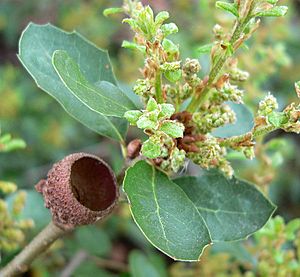Island scrub oak facts for kids
Quick facts for kids Island scrub oak |
|
|---|---|
 |
|
| Conservation status | |
| Scientific classification | |
| Genus: |
Quercus
|
| Species: |
pacifica
|
| Synonyms | |
|
|
Quercus pacifica, also called the island scrub oak or Channel Island scrub oak, is a special type of oak tree. It's a unique plant found only in a specific part of the world.
Where It Lives
This oak tree grows only on the Channel Islands of California. These islands are off the coast of California. You can find it on Santa Cruz, Santa Rosa, and Santa Catalina Islands. Santa Cruz and Santa Rosa Islands are even part of Channel Islands National Park.
Even though it lives on only three islands, it's quite common there. It grows in many different places like grasslands, chaparral (a type of shrubland), and oak forests. On Catalina Island, it's the most common oak tree in many areas. Scientists officially named this species in 1994.
What It Looks Like
The Quercus pacifica is usually a shrub or a small tree. It can grow up to 5 meters (about 16 feet) tall. Sometimes, it can even grow a bit taller.
Its leaves are shaped like ovals. They have pointy teeth along their edges. Each green leaf can be up to 4 centimeters (about 1.6 inches) long and wide. The top of the leaves is shiny. The underside is a bit waxy, hairy, and has tiny glands.
The acorn of this oak has a cap that can be up to 2 centimeters (0.8 inches) wide. The nut part of the acorn is usually 2 or 3 centimeters (0.8 to 1.2 inches) long.
Sometimes, this oak can mix with another oak species called Quercus lobata. When they mix, they create a new plant. This new plant is a stable hybrid called Quercus × macdonaldii.
Protecting This Oak
This special oak tree faces some threats. A type of honey fungus (a plant disease) can harm it. This fungus often attacks trees that are already weak. Trees can become weak from animals like goats and pigs eating too much of them. These goats and pigs are wild animals that used to be farm animals.
In 2004, scientists found a new type of fungus growing on this oak. It was found inside oak galls, which are strange bumps on the tree. This new fungus was named Penicillium cecidicola.



